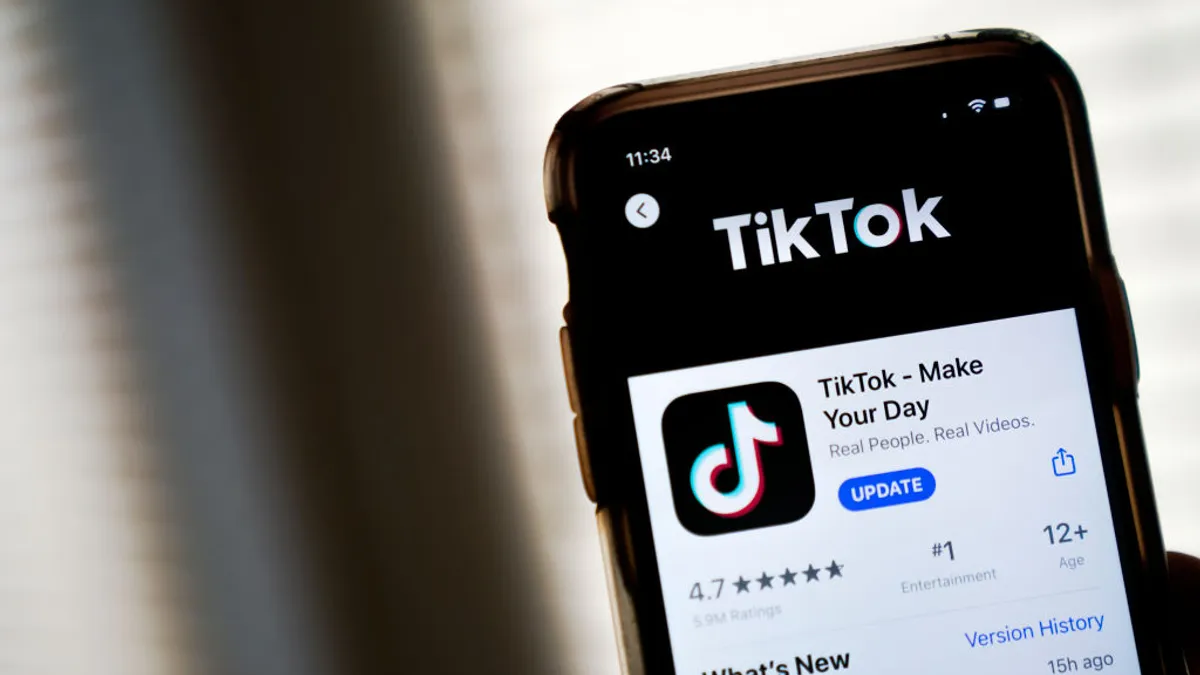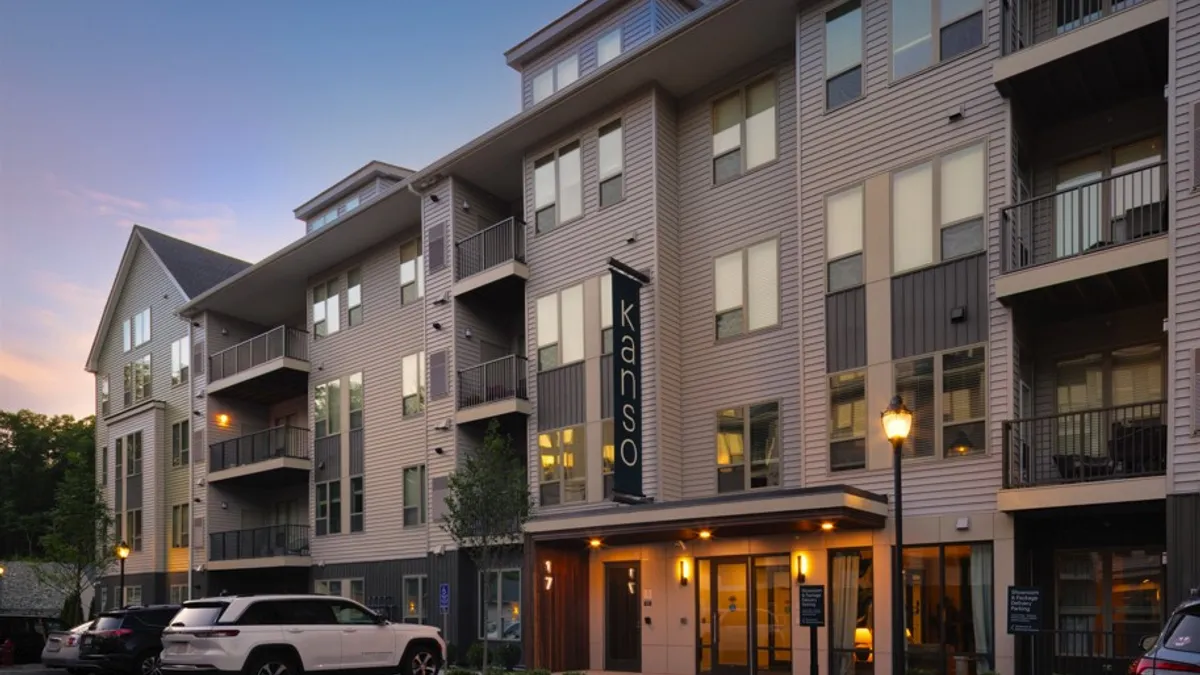The most popular video on the TikTok page for The Kensington, a Boston high rise managed by Bozzuto, features a property tour from the perspective of one of its residents — a golden retriever.
During the 20-second video, viewed over 1,800 times, the dog roams the property on a pink leash, enjoying the rooftop deck and attention from property staff. The piece is set to a clip from “The Assignment” by rapper Tay Money, a trending song on the platform when the video was made.
In every room, as the song emphasizes that “I understood the assignment,” video captions outline the property’s pet policies and amenities:
- “Pet friendly staff.”
- “Allowed in all amenity spaces.”
- “Pet vending machine.”
- “Indoor relief station.”
- “Did we mention NO PET FEES.”
Over dozens of videos, @kensingtonboston has showcased community events, neighborhood landmarks and apartment unit tours for the 381-unit residential tower in Boston’s Chinatown neighborhood. Almost all of them feature the app’s hallmarks, including a short runtime and a trending soundtrack. Bozzuto Management Co. did not respond to requests for comment on this article.
Like Facebook, Twitter and Instagram, TikTok has become the newest frontier for multifamily social media marketing, especially as its core user base — Gen Z — comes of age to start apartment hunting. Many companies have taken the time to learn the ins and outs of the platform, making its unique features work for them and catching the eye of their target audiences.
Experts say there are specific strategies for reaching audiences on the platform, but they differ from the tactics typically employed on more traditional social media outlets.
“[TikTok] is a platform to really show your personality, show your team, show what you do. It’s ... about being relatable and real.”
Mollie Elkman
Owner and President, Group Two Advertising
When searching for “apartments” on TikTok, the most popular results on the platform are unit tours. Their creators are from all walks of life; some are renters who are either showing off a newly rented apartment or the ways in which they’ve decorated it, while others are leasing agents giving tours of properties for rent.
There is the option to promote videos as targeted advertisements on the platform, but in doing so, the videos will be clearly marked as “sponsored.”
Mollie Elkman, owner and president of Group Two Advertising, a home builder marketing firm based in Philadelphia, doesn’t believe this is the most effective move for promoting a property. The audience that uses TikTok is not one that wants to feel as though they are being marketed to, she said.
“When you're creating video content on TikTok, it's really not effective if it comes across as promotional or as an ad in any kind of way,” Elkman said. “This is a platform to really show your personality, show your team, show what you do. It's much more about being relatable and real.”
Instead, what users are looking for is a window into a lifestyle. For instance, if Elkman was looking to attract a renter who was moving to a particular big city for the first time — and perhaps searching for videos about apartments to rent in that city — she would focus content on that city’s particular lifestyle.
“That doesn't mean the people with the company necessarily doing a talking head video talking about the city,” Elkman said. “It could be showing a parade or what's happening on a Saturday — content that's less about the brand and more about the lifestyle.”
As you’re figuring out what your strategy should be, Lynn Maurer, account executive at Beaverton, Oregon-based Digital Marketing Group, recommends seeking out creators in the real estate space, seeing what they do and customizing the best ideas out there for your own needs. “TikTok is all video, so make it compelling,” Maurer said.
Tips and tricks
In order to engage audiences on TikTok, multifamily marketers need to take full advantage of its features.
Hashtags are familiar enough from other platforms. The way you mark your video will determine who sees it, and tags can trend either globally or within a particular geographic area.
“The hashtag game is strong on TikTok,” says Maurer. “Spend some time researching what hashtags people are using in areas and by people that look to be the best prospective renters.”
One tool unique to TikTok is trending sounds – clips from songs, TV shows or other sources that users can play over their videos, such as the Tay Money clip that The Kensington used. (Make sure that the trending sound is cleared for commercial use before placing it over a video.)
Clicking an icon in the bottom right corner of a TikTok video takes users to a page where they can view more videos set to the same sound, no matter their source. If a user is particularly attached to a sound, they’ll find your video if you use it.
“There are always trending sounds and hashtags [on TikTok],” Elkman said. “If those sounds are relevant to your product in your brand, you would want to use those sounds or use those hashtags [in your videos] — but only if it's really relevant to your audience.”
Making videos isn’t the only way to build a presence on TikTok. Nikki Kirkland, social media coordinator at Group Two, recommends engaging with other popular content in order to build a brand. This can include commenting on videos, reposting other videos, or “dueting,” in which a user can make a video play side-by-side with another user’s video, usually as a response to it.
“This humanizes the brand and also gets you noticed without creating content,” Kirkland said. “Take [the language learning app] Duolingo for example. This brand gained its popularity on TikTok by commenting on trending videos and/or duetting them. Now they have gained a massive following.”
Influencers are also a force of power on the app. A user with millions of followers could move into a building, post a tour on their page, and suddenly give a property thousands of impressions. However, the opposite is also true — if your property falls out of favor with that influencer, they’re likely to share that fact with a wide audience.
"TikTok is all video, so make it compelling."
Lynn Maurer
Account Executive, Digital Marketing Group
Elkman doesn’t necessarily recommend starting out with an influencer-focused strategy. “I would say that’s something to explore more as you get used to the platform,” she said. “[And] think about influencers that are relevant in the space. If you have apartments in a specific area, look for local voices or local influencers that may be on a much smaller scale.”
If you do seek out partnerships with influencers, it’s best to come prepared. “My recommendation is to find a few local micro-influencers and start a conversation about what they would like to do if you worked together,” Maurer said. “Set clear expectations and approval rights before anything can be posted on your behalf.”
The next big thing?
While TikTok may be the biggest social media force for Gen Z right now, it is only the latest in a long line of social media platforms to have their day in the limelight. Given the way the landscape has changed over the last 20 years alone, Elkman does not doubt that something new could come over the horizon soon.
“Social media is going to always change. There's going to be new social media sites, new tactics, new things,” Elkman said. “Marketing in our industry used to change every two or three years. Now it is literally changing every single day.”
For now, many multifamily companies have elected to stay on the sidelines. Numerous apartment marketers told Multifamily Dive their clients have yet to implement any strategy on the short-form app.
There’s also the question of political and social backlash against TikTok, due in part to allegations regarding its data security practices.
Former U.S. President Donald Trump attempted to ban the app nationwide in 2020 by executive order if it was not sold by its parent company. While this did not come to pass, the current administration has recently ordered all employees of federal agencies to remove Tiktok from any government-issued phones within the next 30 days.
The app is also banned on state government devices in 32 out of 50 states. And a bill making its way through Congress could, if passed, empower President Joe Biden to ban the app completely.
While even a partial ban could stop a TikTok marketing strategy in its tracks, Elkman says that moving from one platform to another is nothing new in the social media marketing space.
“If any government or state was going to ban something, then we would have to go to the next place where people are going,” Elkman said. “It’s all about the renters and their experience. Where are we going to show up where they are now? It’s TikTok. And if it isn’t TikTok next week? It’ll be the next thing.”



















